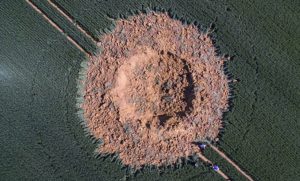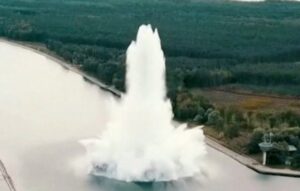 During World War II, there were hundreds of thousands, if not millions, of bombs dropped across Europe. There is no way to know where they were dropped, or if they actually exploded, or worse yet, if they are still lurking beneath the surface waiting to detonate. Princess Diana was a champion of a similar cause, but she was concerned about landmines…just as deadly, but a different deployment. Both concerns are real, and both situations are deadly. One German bomb specialist said that the problem will haunt Europe for centuries, saying, “There will still be bombs 200 years from now.”
During World War II, there were hundreds of thousands, if not millions, of bombs dropped across Europe. There is no way to know where they were dropped, or if they actually exploded, or worse yet, if they are still lurking beneath the surface waiting to detonate. Princess Diana was a champion of a similar cause, but she was concerned about landmines…just as deadly, but a different deployment. Both concerns are real, and both situations are deadly. One German bomb specialist said that the problem will haunt Europe for centuries, saying, “There will still be bombs 200 years from now.”
One such example is that of the German town of Limberg, whose residents woke up to a startling sight on the morning of June 23, 2019. A crater in a field as large as a house. The explosion was caused by a leftover bomb from World War II. Unexploded bombs really are a huge problem in Germany and other European countries, because these long-buried weapons periodically surface or spontaneously explode. No one knows when it might happen and the aftermath can be devastating. The explosion occurred in the central German town of Ahlbach, just north of Frankfurt. Residents reported hearing and feeling a large explosion in the early morning hours of Sunday the 23rd, but no one actually saw the explosion occur. During a follow-up the next day, they found a crater 33 feet wide and 14 feet deep in the middle of a barley field. It was determined that a decomposing bomb detonator for the explosion.

According to the BBC, “explosive ordnance demolition teams concluded that the explosive device was a 551 pound aerial bomb dropped by the Allies during World War II. The bomb was likely a M43, AN-M43, or AN-M64 500 pound general purpose bomb. General purpose bombs at terminal velocity will penetrate 3-4 building stories before detonating, so it’s not surprising this bomb buried itself so well.”
“The M65 was five feet long and 14 inches wide, and carried a payload of 280 pounds of TNT. The bomb casing, designed to produce fragment into lethal shrapnel, was .3 inches thick. An explosive ordnance disposal guidebook describes their purpose as to destroy ‘steel railway bridges, underground railways, sea craft such as light cruisers, concrete docks, medium sized buildings, etc.’”
During World War II, Germany operated several facilities in areas important to the war effort, including Limburg Field and an important railroad junction and marshaling yard. Allied bombs were dropped during the war, but often missed by miles. Falling at a high rate of speed, that morning’s bomb buried itself in the soft soil and  remained undetected for decades. Whoever cultivated the barley field obviously had no idea 280 pounds of highly unstable explosives lurked underneath, and thankfully no one was hurt
remained undetected for decades. Whoever cultivated the barley field obviously had no idea 280 pounds of highly unstable explosives lurked underneath, and thankfully no one was hurt
Seventy five years after the end of World War II, unexploded bombs are still a huge problem not only in Germany, but across all of Europe. The explosions don’t happen often, but when one explodes the results can be devastating. Governments are trying to find these bombs. Experts drill holes and look for bombs using magnetometers, searching for the signature of a bomb’s steel casing. Then they defuse or explode them harmlessly.


Leave a Reply